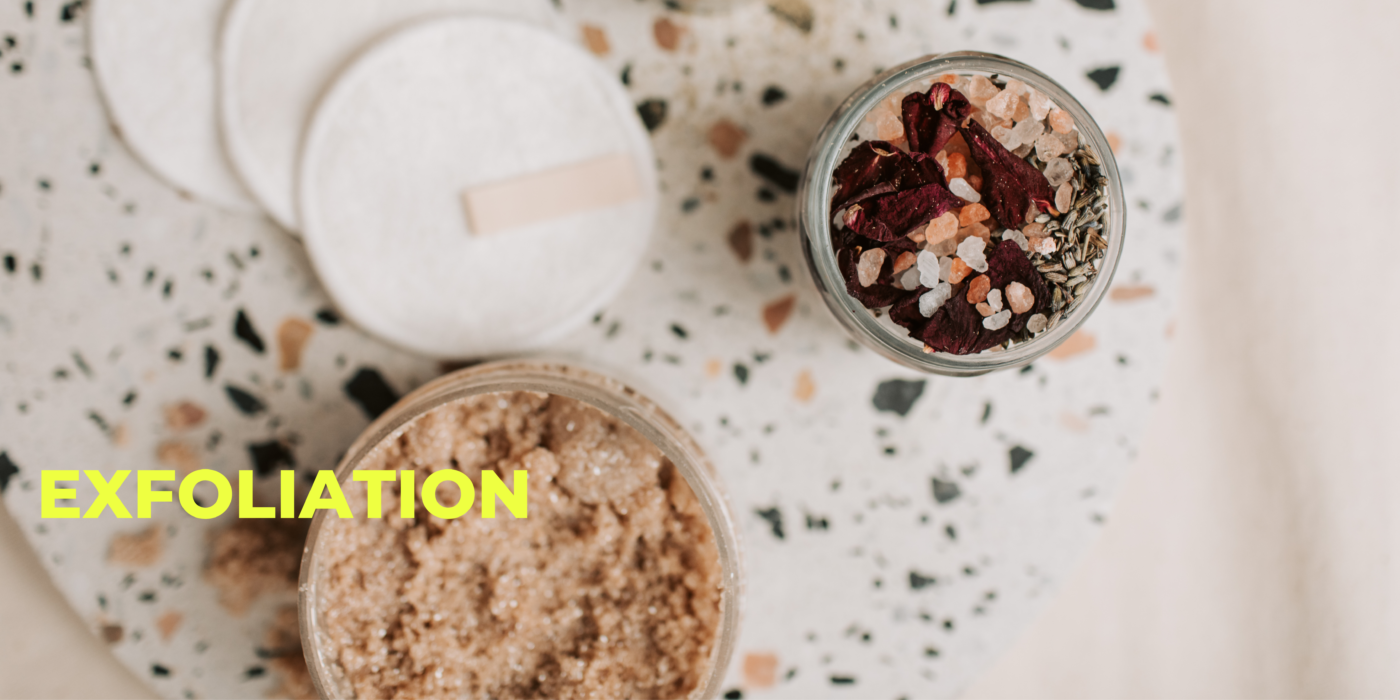Skin Care
Exfoliation
What is exfoliation?
The skin naturally sheds every 30 days to make room for new skin cells. However, there are instances when dead cells don’t shed off the skin completely, leaving our skin dry and flaky with clogged pores.
Exfoliation is the process of getting rid of dead skin cells from the outer layer of the skin, preventing clogged pores and rejuvenating dull skin. The result? Fewer breakouts, improved appearance of the skin, increased blood circulation to the skin, improved absorption of serums and moisturisers, and increased collagen production in the long term.
NB: NB: Exfoliation is vital to include in your skincare routine for optimum skin health, for beginners, start with exfoliating 1-2 times a week.
Types of exfoliation
There are two main types of exfoliation you can add to your skincare routine namely physical and chemical exfoliation. Each type of exfoliation has its own benefits and drawbacks. It really depends on what skincare concern a person is trying to treat. (Goldsbury, 2011).
- Physical exfoliation
Physical exfoliation entails manual scrubbing or rubbing using tools such as scrubs, powders, washcloths, sponges, gloves, pumice stones, or brushes to physically remove dead skin cells.
- Chemical exfoliation
Chemical exfoliation uses chemicals such as alpha-hydroxy acids, polyhydroxy acids, and beta hydroxy acids to gently dissolve dead skin cells. Alpha hydroxy acids are plant-based ingredients that help to dissolve dead skin cells on the surface of the face.
Polyhydroxy acids gently remove dead surface cells, hydrate, and smoothen skin. Beta hydroxy acids, on the other hand, remove oil, dirt, and debris and are great for eliminating blackheads and whiteheads thanks to their anti-inflammatory and anti-microbial properties.
How to exfoliate by skin type
The type of exfoliation you opt for should be guided by your skin type. If you have normal skin both physical and chemical exfoliation is safe for you. If you have acne-prone, dry or sensitive skin, include a mild chemical exfoliator into your skincare routine or when using a physical exfoliation be extremely cautious and avoid harsh scrubbing. Our curated Neulii exfoliating toner pads for sensitive skin are the perfect balance of chemical and physical exfoliation and perfect for most skin types, shop here.
Tips to prevent skin damage while exfoliating
- Use the right exfoliator
Avoid using harsh scrubs, sponges or gloves on your face. These physical exfoliators work better on the rest of your body e.g. neck, armpits, elbows, arms, hands, legs, knees, and feet. Only use exfoliants meant for your face in your skincare routine so you don’t subject your delicate skin to unnecessary irritation.
- Moisturize immediately after exfoliating
After exfoliation, moisturise immediately to lock in all the hydration in the skin barrier to leave your skin feeling plump, supple and soft. Shop our curated by Uncover Neulii squalane desertica moisture cream here.
- Be gentle to your skin
While using physical exfoliators, be mindful to not scrub too hard as this could lead to small micro tears in the skin, do not over-exfoliate even when using gentle chemical exfoliants. If you begin to notice irritation, stop exfoliating immediately and make some changes.
Need some guidance? Our in-house certified skincare therapist, Joyce Waiharo can support you through finding the exfoliants for you and the right frequency of use. Book your one-on-one consultation here.
- Exfoliate before layering other products in your skincare routine
For best results, exfoliate after cleansing, then layer the remainder of your products. This enables maximum absorption of your skincare products. Learn more from our beginner’s guide here.
NB: If you’re treating acne or oily skin and are looking for a gentle exfoliant to use everyday, opt for our curated by Uncover AC clean saver foam cleanser, shop here. For best results, follow with our curated Neulii Derma Ecto-Cica 11 Toner as the next step in your skincare routine.
How often do you exfoliate? What’s your go to method for dead cells removal? Let us know in the comments below.
